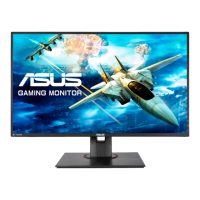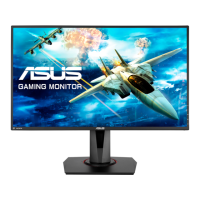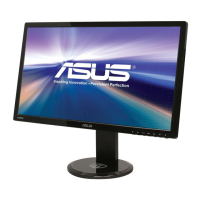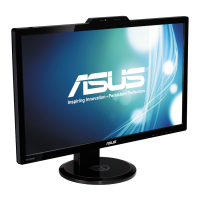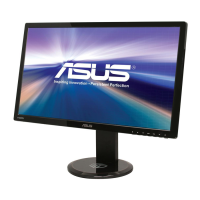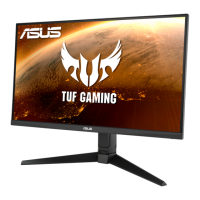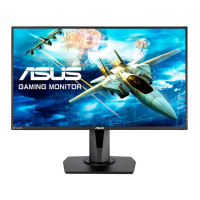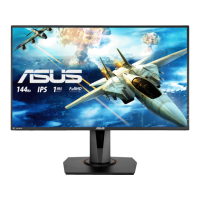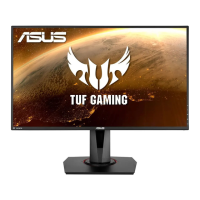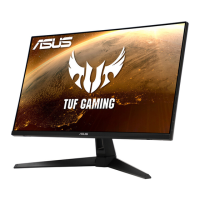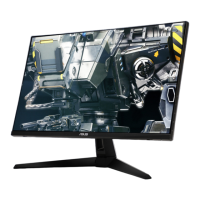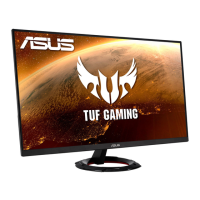Do you have a question about the Asus Vg278Q and is the answer not in the manual?
Step-by-step guide to attaching the monitor stand and base securely.
Instructions for tilting, swiveling, and adjusting the monitor's height for comfortable viewing.
Guides on connecting the monitor to power and the computer using various cables.
Instructions for turning the monitor on and understanding the power indicator status.
How to access, navigate, and reconfigure settings within the On-Screen Display (OSD) menu.
Addresses frequently asked questions and provides solutions for common monitor problems.
Step-by-step guide to attaching the monitor stand and base securely.
Instructions for tilting, swiveling, and adjusting the monitor's height for comfortable viewing.
Guides on connecting the monitor to power and the computer using various cables.
Instructions for turning the monitor on and understanding the power indicator status.
How to access, navigate, and reconfigure settings within the On-Screen Display (OSD) menu.
Addresses frequently asked questions and provides solutions for common monitor problems.
| 3D | - |
|---|---|
| Panel type | TN |
| Color gamut | 72 % |
| Pixel pitch | 0.311 x 0.311 mm |
| Screen shape | Flat |
| Display surface | Matt |
| Display diagonal | 27 \ |
| Display technology | LED |
| Native aspect ratio | 16:9 |
| Viewing angle, vertical | 160 ° |
| Contrast ratio (dynamic) | 100000000:1 |
| Contrast ratio (typical) | 1000:1 |
| Display number of colors | 16.78 million colors |
| Viewing angle, horizontal | 170 ° |
| Digital vertical frequency | 40 - 144 Hz |
| Digital horizontal frequency | 160 - 160 kHz |
| Display brightness (typical) | 400 cd/m² |
| Supported graphics resolutions | 1920 x 1080 (HD 1080) |
| On/off switch | Yes |
| Active display area (W x H) | 597.6 x 336.15 mm |
| Headphone connectivity | 3.5 mm |
| VGA (D-Sub) ports quantity | 0 |
| Certification | BSMI, CB, CCC, CE, CEL level 1, CU, ErP, FCC, J-MOSS, KCC, PSE, RoHS, UkrSEPRO, UL/cUL, VCCI, WEEE, WHQL (Windows 10, Windows 8.1, Windows 7), MEPS, RCM, TUV Flicker-free , eStandby, TUV Low Blue Light |
| Product color | Black |
| Market positioning | Gaming |
| RMS rated power | 4 W |
| AMD FreeSync type | FreeSync Premium |
| NVIDIA G-SYNC type | G-SYNC Compatible |
| Tilt angle range | -5 - 33 ° |
| Cable lock slot type | Kensington |
| Panel mounting interface | 100 x 100 mm |
| Energy efficiency scale | A to G |
| Power consumption (off) | 0.3 W |
| Power consumption (standby) | 0.5 W |
| Power consumption (typical) | 26.1 W |
| Power consumption (PowerSave) | - W |
| Package depth | 190 mm |
| Package width | 700 mm |
| Package height | 458 mm |
| Package weight | 8200 g |
| Harmonized System (HS) code | 85285210 |
| Depth (with stand) | 211 mm |
|---|---|
| Height (with stand) | 506 mm |
| Weight (with stand) | 5600 g |
| Depth (without stand) | 50 mm |
| Width (without stand) | 619 mm |
| Height (without stand) | 363 mm |
| Weight (without stand) | 3200 g |
